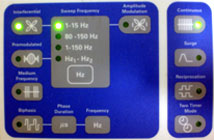|

Interferential current therapy (IFC)
is one of many modalities which may be utilized in the physical
therapy plan of care to assist with decreasing pain, stimulating
muscle, reducing edema and increasing circulation (1, 2). The
purpose of IFC therapy is to deliver currents into deeper tissue by
overcoming skin impedance (2, 3, 4, 5). To accomplish this feat, it
involves the creation of a waveform produced by the interference of
two medium frequency sinusoidal, symmetrical, alternating currents
at frequencies of several thousand cycles per second which are set
at slightly different frequencies (ie. fixed carrier frequency of
4,000 Hz and second adjustable frequency of 4,001-4,400 Hz)
(1, 2, 3, 4). These two waveforms are delivered through two sets of
electrodes through separate channels in the same stimulator (3).
These electrodes are oriented in a quadripolar orientation which
allows for the two alternating currents to intersect (3, 4). As a
result of the currents intersecting they interfere and create the
desired signal frequency (3, 4). The IFC stimulation is thus
concentrated at the point of intersection between the electrodes
(See Figure 1 below).
Figure 1 - Intersecting medium
frequency alternating currents producing an interferential current
between two crossed pairs of electrodes (2, 3,6)
|
 |
Despite its wide use in the physical therapy setting, studies
regarding its efficacy vary and are somewhat lacking (2, 5). In a
study by Johnson et al. (2) they compared the analgesic effects of
IFC and TENS on experimentally induced ischemic pain in otherwise
pain-free subjects using a modified version of the submaximal-effort
tourniquet technique. They concluded that there were no differences
in the magnitude of analgesia between IFC and TENS. They did find
that IFC reduced pain intensity to a greater extent than sham
electrotherapy.
In a systematic review and meta-analysis conducted by Fuentes et al.
(5), they analyzed the available information regarding the efficacy
of IFC in the management of musculoskeletal pain. They discovered a
total of 2,235 articles but were only able to utilize 14 studies
which met their inclusion requirements. From their meta-analysis,
they concluded that IFC as a supplement to another intervention
seems to be more effective for reducing pain than a control
treatment at discharge and more effective than placebo treatment at
the 3 month follow up. However, they were unable to conclude if the
analgesic effect of IFC is superior to that of the concomitant
interventions. They also found that IFC alone was not significantly
better than placebo or other therapy at discharge or follow up.
Additional research is required when examining the use of IFC as an
isolated treatment as only four studies with mixed results were
found that met this criteria (5). However, studies do support that
IFC as a supplement to another physical therapy intervention is
effective for reducing pain (5). This in turn, does open up the need to
conduct studies comparing IFC to the various other physical therapy
interventions.
Last revised: October 20, 2011
by Chai Rasavong, MPT, MBA
References
1) Goats GC, Inferential Current Therapy. Br. J. Sports Med.
1990;24:87-92.
2) Johnson MI, Tabasam G. An investigation Into the Analgesic
Effects of Interferential Currents and Transcutaneous Electrical
Nerve Stimulation on Experimentally Induced Ischemic Pain in
Otherwise Pain-Free Volunteers. Physical Therapy.
2003;83(3):208-223.
3) Cameron M. Physical Agents in Rehabilitation: From Research to
Practice. Saunders. 2003;222-223.
4) Robinson AJ, Snyder-Mackler L. Clinical Electrophysiology:
Electrotherapy and Electrophysiologic Testing - Second Edition.
Williams & Wilkins. 1995;65-67.
5) Fuentes JP, et al. Effectiveness of Interferential Current
Therapy in the Management of Musculoskeletal Pain: A Systematic
Review and Meta-Analysis. Physical Therapy. 2010;90(9):1219-1238.
6) May H-U, Hansjurgens A: Nemectrodyn Model 7 Manual of Nemectron
GmbH, Daimlerstr. 15, Karlsruche/Germany, 1984.
|








